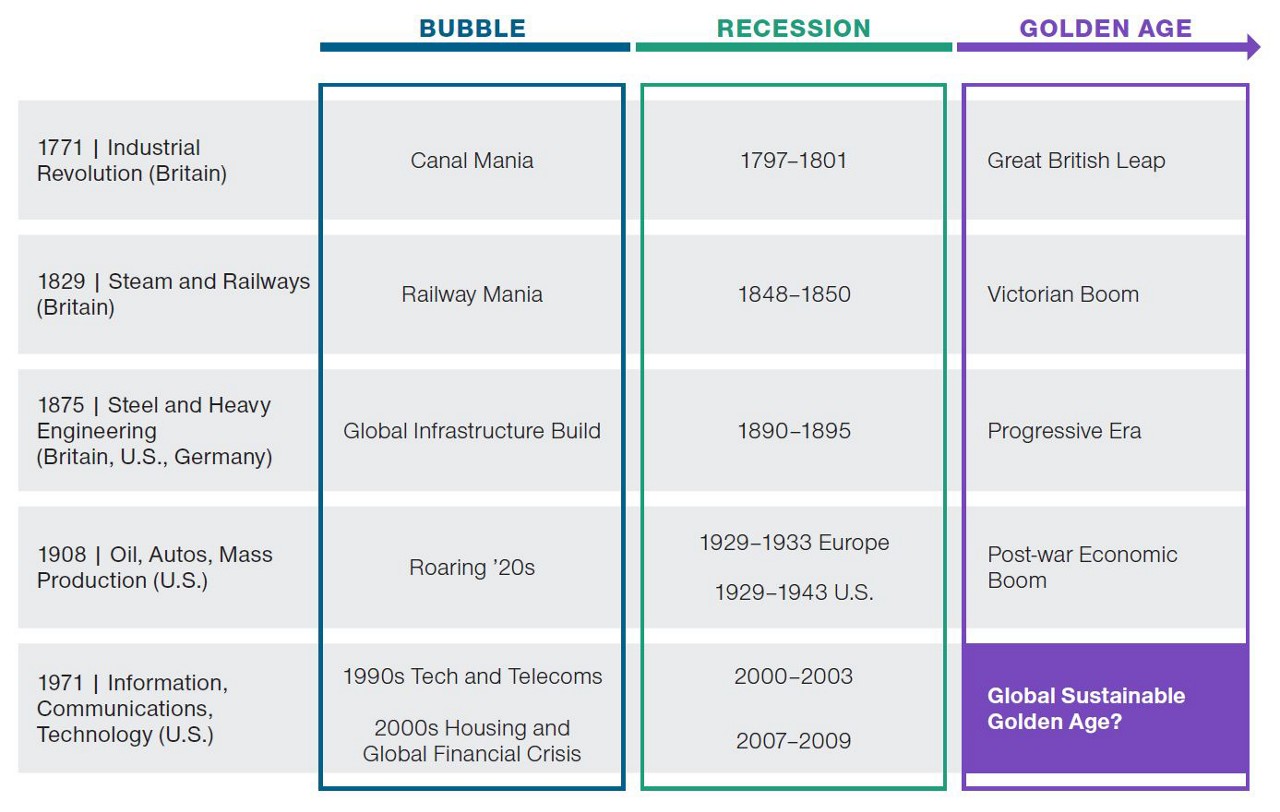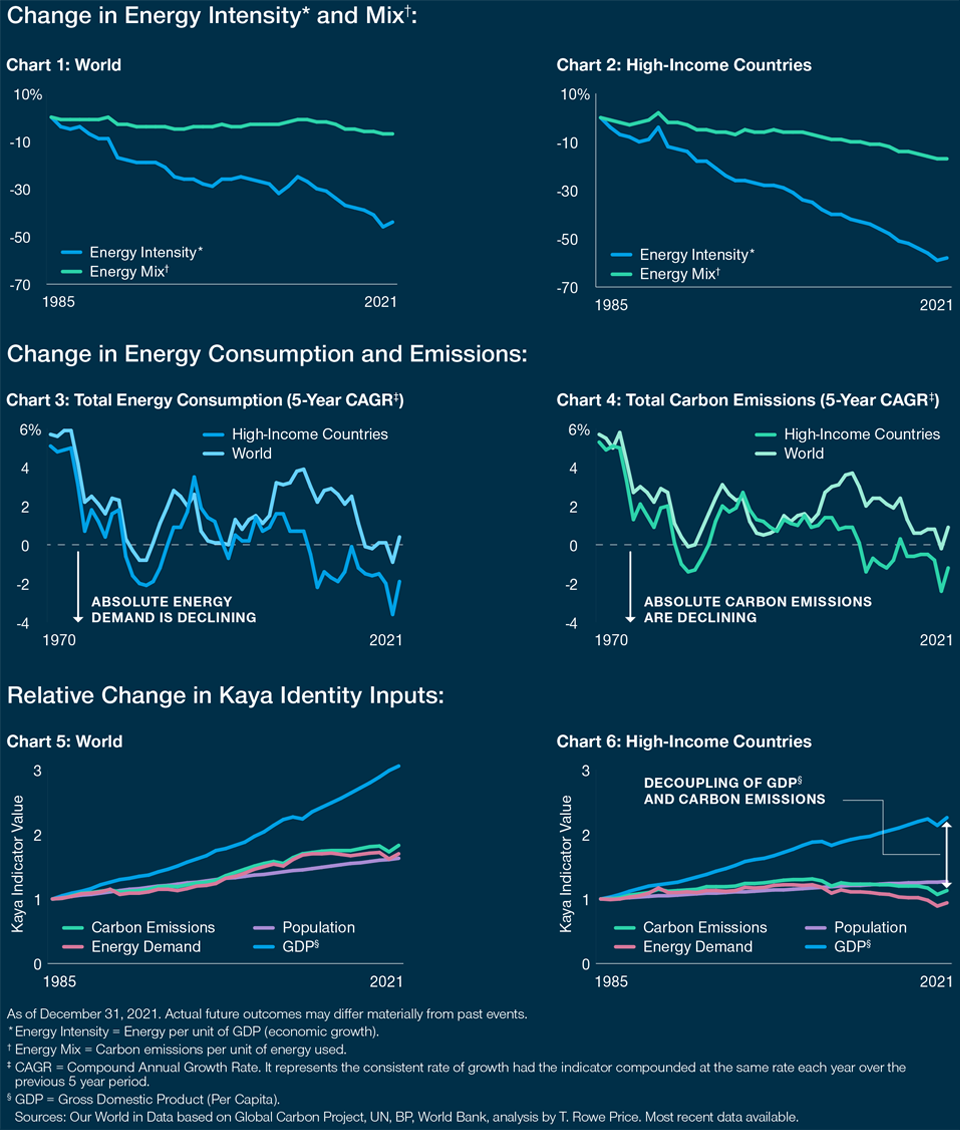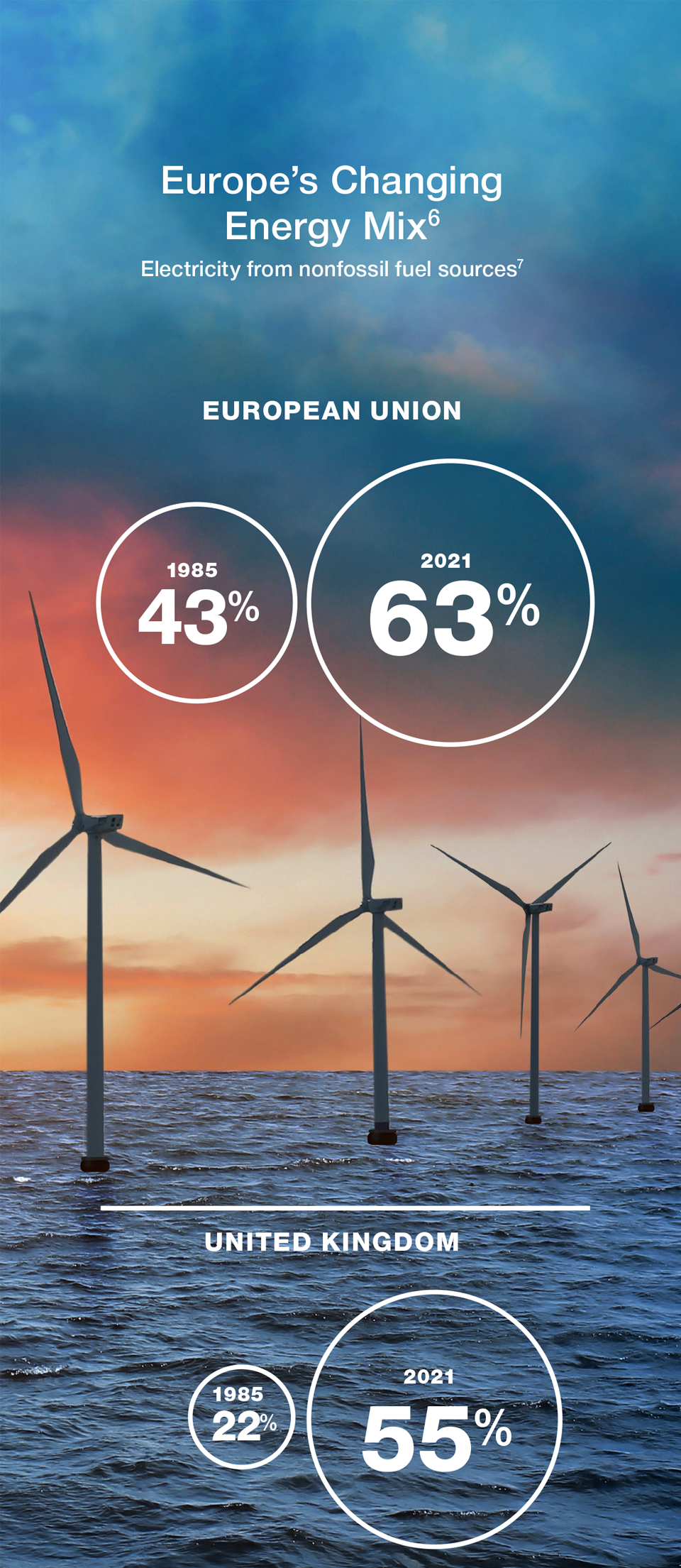Keeping pace with the energy transition
In 2020 and 2021, market commentators were eager to herald the impending death of the fossil fuel industry. Oil and gas prices were depressed due to the pandemic’s impact on energy demand, and investors had trimmed energy holdings, leaving the sector with very low valuations.
When the world started to reopen after the pandemic, demand picked up, boosting oil and gas prices. This was followed by Russia’s invasion of Ukraine, which caused a major supply disruption from one of the world’s largest oil and gas exporters. The media and other commentators then pivoted to herald the demise of ESG.
The reality is that both accounts were too short-sighted and alarmist. Energy transition is a monumental undertaking that will take many decades – it is deeply complex, and its success or failure cannot be measured in yearly increments. A common way to demonstrate the energy transition is the energy mix required to reach net zero1 by 2050 and stay within a 1.5°C pathway.2 Given that this is a forward-looking scenario, it is typically illustrated as a straight-line transition, which can create an overly simplistic perception of the journey. In reality, there will be many ups and downs as the multitude of factors driving energy supply and demand play out. The simplified straight-line transition forecast will ultimately be made up of many twists and turns.
Following the post-pandemic economic rebound and energy crisis, the tone and rhetoric on energy transition turned decidedly negative in 2022. However, we believe there are many positive‑leaning factors that should be considered when evaluating the pace of change.
- First, a look at historical technological revolutions indicates that the social tensions we are currently experiencing are very normal for this type of change—in the past, they have indicated a turning point ushering a period of economic prosperity.
- Second, some progress is being made on energy transition, and global figures may not be the most informative indicators.
- Third, the idiosyncrasies of energy transition (in comparison with other technological revolutions) will make regulation a critical driver of success or failure.
Past technological revolutions: Growth followed social upheaval
Historical technological revolutions have displayed a pattern of new technologies displacing established industries and destroying jobs on a huge scale, followed by a prolonged period of prosperity. Because financial capital drives the mobilisation of production capital into new technologies, it is not uncommon to experience asset bubbles and crashes. These, in turn, reveal the inequalities that have resulted from the new technology.
In their study titled Technological Revolutions: Which Ones, How Many and Why It Matters: A Neo‑Schumpeterian View, Carlota Perez and Tamsin Murray Leach highlighted that each technological revolution had a “turning point,” which heralded a golden age characterised by a great surge of development. While technological revolutions tend to create volatility and may destroy many jobs in the short term, in the long run, more jobs tend to be created, although often in new industries or geographies.
Notably, new jobs can emerge in areas that were previously unimagined. However, these new opportunities may not be suitable to the existing skill set of the unemployed, particularly if created outside the new high-tech sectors or in a different geography. For example, the age of oil, autos, and mass production led to a rise in suburban living in the US, generating demand for housing and new consumption patterns.
Given the level of social displacement and recession that inevitably followed asset bubbles and crashes, it was not uncommon to see a rise in populism and heightened political division. Historically, a new golden era of economic growth followed the recessionary turning point, when the new technology moved from a niche application to a broader one.
The sustainable Golden Age?
Historical technological revolutions have followed a pattern, with a bubble emerging, followed by a recession, and then a golden age of development.

Source: Based on Perez 2016—Perez, C (2016) “Capitalism, technology and a green global golden age: the tole of history in helping to shape the future” in Mazzucato and Jacobs (eds), Rethinking Capitalism. London: Wiley Blackwell.
This revolution has a few twists
We believe that the transition to clean energy is indeed a technological revolution, but it has some distinctly different characteristics than prior revolutions.
The first is that the increase in productivity from clean energy is not as clear-cut as other instances, where the new technology provided immediate and direct benefits to the consumer.
In the case of energy transition, the benefit will be derived from two sources—one has a clear and direct benefit to the consumer (energy efficiency), while the other is less direct (renewable energy).
An easily observable direct benefit to industry from energy efficiency is that more efficient resource use leads to lower costs. The contribution of energy efficiency in net zero scenarios is substantial. In the International Energy Agency’s net zero scenario, absolute energy demand is forecast to decline by 16.5% between 2020 and 2050, despite continued population and economic growth.3 A review of 77 different 1.5°C scenarios indicated that the median decline in energy use per capita would fall 37%.4
The benefits to the consumer from renewable energy and decarbonisation are more circuitous. For example, renewable energy benefits from less cyclicality than fossil fuels, which has an economic benefit for manufacturers (although, in many cases, it still requires subsidies or carbon tax avoidance for it to be the most economically efficient source of energy).
Renewable energy is usually generated domestically, which brings improved security of supply. Renewable energy also brings public health benefits – air pollution from fossil fuels (one of the leading causes of premature death globally) caused USD 2.9 trillion in health and associated economic costs globally in 2018, according to the World Health Organization.
And, last but not least, decarbonisation from the transition to renewable energy should mitigate the worst effects of physical risk that will result from global warming.
The interaction between new clean energy technologies and the products they displace will also be different from the historical experience. In prior technological revolutions, new technologies coexisted with those they eventually displaced for very long periods of time. However, to stay within a 1.5°C warming scenario, this coexistence will not be feasible, meaning regulators must actively work to displace fossil fuels.
Another differentiator is that energy transition sits within a broader technological revolution that happens to align with the needs of sustainable innovation – namely, the information revolution. This brings its own potential to drive a different type of social disruption than experienced historically.
Previous revolutions have focused on replacing physical work with machines, while the information revolution is about replacing mental power with digital technologies and artificial intelligence. Not only are two technological revolutions acting to displace workers, but the information revolution will likely create an altogether different type of displacement than previously experienced.
Measuring progress – Watch the leading indicators
As a byproduct of combustion, greenhouse gas emissions have been linked to economic growth since the start of the Industrial Revolution. Reducing greenhouse gas emissions without disrupting economic growth requires changes in the way energy is produced and lost to inefficiencies, both of which require significant long-lived capital investment. This means, at the current stage of the transition, the measurement of progress must focus on leading indicators.
Chart 1, as shown below, illustrates that, on a global basis, a strong improvement in energy intensity (amount of energy per unit of economic growth), but only modest progress in energy mix (CO2 emissions per unit of economic growth).
For high-income countries,5 trend improvements in energy intensity and energy mix are more pronounced (Chart 2). Furthermore, absolute energy demand (Chart 3) and carbon emissions (Chart 4) have been mostly declining for more than a decade.
For high-income countries, we are also starting to see a decoupling of gross domestic product growth and carbon emissions. This is most clearly illustrated by data known as the Kaya Identity (Charts 5 and 6).
The Kaya Identity expresses the total emissions of carbon dioxide as a product of four factors: population,
- GDP per capita,
- energy intensity, and
- carbon intensity (emissions per unit of energy consumed).
It is a helpful tool to understand decarbonisation trends and their relationship to economic growth and population change. Because virtually every government deploys policies to drive GDP growth and few countries are willing to make policies that materially change population growth, the potential for political influence really sits with the latter two of the formula’s four components (energy and carbon intensity).
The progress made in high-income countries predominantly reflects changes in the electricity generation mix, which we estimate is roughly halfway through its transition.
In the coming years, we expect several “next acts” of the energy transition to accelerate—namely decarbonisation of transportation, industry, and buildings. As energy transition investments extend beyond electricity generation in a much more meaningful way, we expect the investment opportunities to expand across many sectors, potentially creating a “golden age” akin to those seen in prior technology revolutions.

Predicting change – Science and economics
Scientific models have generally proven to be accurate about the pace and impact of climate change. However, economic models have repeatedly underestimated the adoption of clean energy technologies.
We believe a big reason for this is that economic models have struggled to incorporate broader social and systemic feedback loops. For example, many economic models are heavily focused on carbon taxes as the key catalyst for new technology adoption. But in practice, we have seen many companies adopt greener business practices based on a variety of drivers. Some examples of this include expectations for carbon taxes or other punitive regulation, reduced energy cost volatility, consumer preference for greener products, or employee recruitment and retention).
Economic models also generally struggle to cope with factoring in paradigm shifts, which is a highly prevalent issue for energy transition. An interesting example of this was highlighted by the European energy crisis in 2022, which amplified the friction points stemming from green energy deployment across an electricity market designed for the fossil fuel era.
In Europe, most electricity prices are set based on the marginal fuel price, which makes sense for a market dependent on imported fossil fuels. It ensures that the continent can attract the fuel it requires and incentivizes investment to secure supply in the future. However, with renewables, hydroelectricity, and nuclear now generating a majority of electricity supply, is this market structure still the best way to meet European energy requirements? A rebasing of the market structure would represent a type of new equilibrium that is difficult for economic models to factor into their assumptions and would likely lead to faster adoption of renewables and other technologies driving decarbonisation.
The impact of public policy
The idiosyncrasies of energy transition have the potential to drive substantial volatility. We refer here to the following:
- a forced phaseout of the displaced technology (fossil fuels),
- coexistence with the information revolution (displacement of mental power with digital technologies), and
- reliance on subsidies and carbon taxes to make clean energy technologies economically viable.
We expect that regulators around the world will take varying approaches and act at different speeds when progressing through their energy transition. Political will and the resources available to each country will likely be key drivers of the pace of transition.

"As the new technologies continue to increase their market share, new market equilibriums will be set that can drive even faster adoption."
Importantly, we see evidence that clean energy is moving from niche to broader applications. As the new technologies continue to increase their market share, new market equilibriums will be set that can drive even faster adoption.
In many cases, governments will be in a position to smooth the path to reaching these new equilibriums. We believe those who can manage more orderly transitions are likely to create more stable operating environments for the companies and other securities in which we invest.
Energy transition and investing
Regardless of the path taken by governments or the speed of the transition, the pervasiveness of energy transition across the economy makes it an important factor to understand. In our view, a core component of our research analysis along with other investment factors.
Despite the recent ESG backlash, we believe the events of 2022 have likely sown the seeds for a faster energy transition. In Europe, renewables are linked to energy security solutions and received a regulatory boost from the EU Green Deal. In the United States, the Inflation Reduction Act is driving an influx of green capital investment. Meanwhile, unfortunately, the physical risks predicted by climate scientists have continued to materialise.

Invest with confidence
T. Rowe Price focuses on delivering investment management excellence that investors can rely on—now and over the long term. Hit the 'follow' button below for more of our investment insights.
Footnotes
1 Net zero refers to a state where greenhouse gas emissions added to the atmosphere are balanced by removals (such as through forests or carbon capture and storage).
2 The 1.5°C pathway refers to the measures required to contain global temperature increases to 1.5°C above pre-industrial levels.
3 International Energy Agency, World Energy Outlook, 2020.
4 Energy systems in scenarios at net-zero CO2 emissions, DeAngelo, Azevedo et al, Nature Communications (October 2021).
5 High-income countries is a World Bank classification. High-income countries are defined as any with gross national income per capita in excess of USD 13,205 (fiscal year 2023).
4 topics
1 fund mentioned

